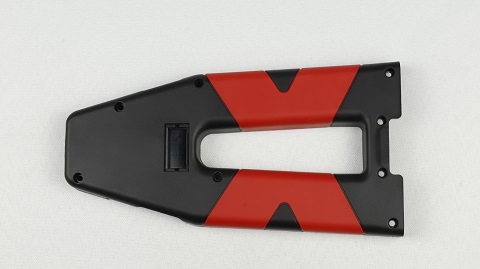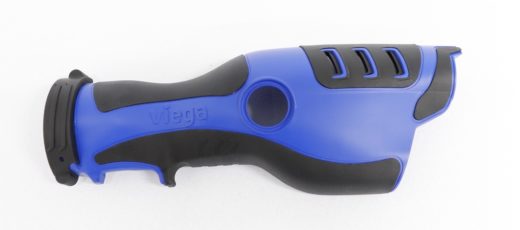Plastic overmolding: what solutions are availables in prototyping?
Plastic overmolding is a first choice solution available in prototyping. Overmolded prototype parts can be designed to preview or test thermoplastic parts prior to their industrial production in large series. What are the different techniques and their advantages? When should you opt for plastic injection molding, rather than vacuum casting? Here is a guide to plastic overmolding for prototyping or pre-production.
What is plastic overmolding all about?
In plastics processing, plastic overmolding consists of injecting an additional layer of material onto an already molded part. Used for rapid prototyping or the manufacture of parts in small series in many sectors of activity, the purpose of this process is to associate a new plastic material with the initial part or to add an insert made of another material, with a view to achieving a precise objective targeted by the manufacturer.
In order to carry out this additional molding process, several precision techniques exist, such as plastic injection and vacuum casting. On the other hand, depending on the type of installation and method used, the plastic overmolding step can be carried out:
- in bi-injection, i.e. in the same mold, immediately after the first molding of each part in the process of production,
- or deferred, in a second mold, after the first molding and the cooling of all the parts to be overmolded.
Why use plastic overmolding in prototyping?
The plastic overmolding process is particularly useful and efficient when designing quality plastic prototypes, within a short timeframe and a reasonable budget. Whether it is to explore new avenues under study in Research and Development, or to validate tests before launching large-scale production of a strategic part, plastic overmolding offers many possibilities in prototyping or pre-production:
- make an improvement,
- change the design, shape or shade,
- experiment with a different finish or texture,
- optimize ergonomics or performance,
- incorporate new mechanical properties or functionalities,
- enhance the protection or protect an insert,
- make the substrate compatible for assembly with another part,
- or any other feature required by the manufacturer.
In order to develop the prototype that meets the specifications with the highest level of precision and reliability, the choice of the plastic overmolding technique is very important. While plastic injection molding will be the most relevant for the manufacture of certain types of parts in small series, vacuum casting will be the most efficient for prototyping and verification of certain elements before industrialization. Let’s take a closer look at the advantages of each method and see in which cases we should recommend one over the other to overmold technical parts.
Which plastic overmolding process should I choose for prototyping?
Prototyping and low volume production of plastic parts with overmolding eliminates or bypasses one or more assembly steps. This can represent a significant saving in time and money when deadlines are short. For this, it will be necessary to choose between the plastic injection molding technique and the vacuum casting technique. On the other hand, it will be necessary to opt for a deferred or bi-injection molding process.
Bi-injection or deferred plastic overmolding?
Easier to implement, faster and much less expensive than bi-injection, the deferred overmolding process is by far the most suitable for prototyping and pre-production or small series manufacturing. By using two separate molds for molding the substrate and for injecting the part to be overmolded, the deferred process offers more flexibility and facilitates experimentation in the rapid prototyping phase, especially if the shape and materials of the final plastic part are still under consideration.
However, if the quality of the chemical bond between the substrate material and the resin to be injected is a priority criterion in the design of the prototype, bi-injection molding can be considered. Indeed, with a bi-material injection molding machine, each part is molded and instantly hot overmolded in the same injection mold, which guarantees an optimal chemical bond between the support and the part overmolded by thermoplastic injection.
In deferred overmolding, obtaining a good chemical bond will depend above all on the choice of a resin that is perfectly compatible with the substrate material on which it will be injected. In conclusion, the deferred plastic overmolding process should be preferred in rapid prototyping in most cases.
Example of deferred plastic overmolding in plastic injection: black PAGF30 with overmolding of TPU Shore 80 in red, meanwhile integrating an overmoulding of 4 stainless steel inserts.
Plastic injection overmolding in prototyping
Plastic injection molding is commonly used in mass production parts, especially when molding with inserts. For prototyping, a simplified prototype mold or aluminum mold (more economical) can be created as well as cavities in order to perform visual and mechanical tests on overmolded parts with properties almost identical to those that will be produced in medium and large series.
Prototech Asia masters the technique of overmolding by plastic injection for rapid prototyping. Our engineering department designs a customized tooling plan from your specifications and the 3D modeling of your part to be molded and overmolded. Our factory will then manufacture your prototype molds in a few weeks and produce a small series of overmolded parts.
Vacuum casting plastic overmolding for prototyping
Particularly suitable for the design and production of a prototype, a pre-series or a small series, overmolding by vacuum casting is also called silicone molding, or vacuum duplication. This particular vacuum molding technique is highly reliable and qualitative in rapid prototyping. It allows overmolding and duplication of dozens of plastic part prototypes.
After the creation of the master model by 3D printing or 3D machining, then a silicone mold, a polyurethane injection is performed in the latter by vacuum suction. Then, the overmolded prototype undergoes an oven passage to harden the resin and a demolding. The result obtained is very close to the serial injection part, whose material is imitated wonderfully by the polyurethanes.
Advantages of vacuum casting for prototyping
In rapid prototyping, vacuum plastic casting has undeniable advantages over other techniques. For example, the hardness of the injected polyurethane material can be adjusted if a part needs to be overmolded with a soft part. The vast choice of vacuum casting resins opens up many possibilities for experimentation and manufacturing. Any color or transparency effect can be achieved.
In addition, the silicone mold is reusable (although with a limited life span), which allows for economies of scale and significant time savings. The overmolded parts are thus identically duplicated with a maximum level of precision. In addition, the elasticity of the silicone mold is an advantage in case of complex geometry of the prototype to be created.
Currently, Prototech Asia is one of the few companies offering you this technology of rapid prototyping by overmolding in vacuum casting.
Prototypes, pre-series or low volume of less than 100 parts are obtained quickly and are perfectly adapted to any type of assembly test, visual test, functional test, mechanical test, market test, or certification test. To decide quickly and safely on a model of plastic part to produce or market, vacuum casting is the most competitive prototyping technique, even compared to 3D printing and CNC machining between 10 and 100 prototype parts.





 We don´t share your data.
We don´t share your data.